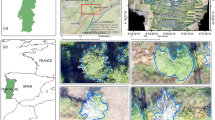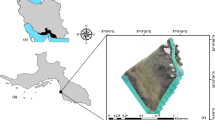Abstract
Identifying special species in tropical forests is an important topic in forest resource management, and the use of a single type of remote sensing data for identification of species has limited accuracy. To analyze the ability of various unmanned aerial vehicle (UAV) remote sensing data for identifying target species, this study used three types of UAV remote sensing data (light detection and ranging (LiDAR), red, green, blue (RGB), and multispectral) to identify Dacrydium pierrei Hickel (D. pierrei) in Chinese tropical forests. The study compared the effects of using various combinations of UAV remote sensing data on the accuracy of D. pierrei identification and identified the optimal combination. (1) Random forest feature selection improved the accuracy of identification of D. pierrei by UAV multiple source remote sensing data: The producer accuracy (PA) was increased up to by 4.62%. (2) The following eight features were most useful for identifying D. pierrei: four features from multispectral images (DR_Standard, RE_Standard, DR_Mean, and B_Brightne), two features from RGB images (B_Standard and B_Mean), and two features from LiDAR images (INT_kurtosis and INT_aad). (3) Combining remote sensing data by integrating up to three types of data sources improved the accuracy of D. pierrei identification. When using a single type of remote sensing data, multispectral data gave the highest identification accuracy. When combining two types of remote sensing data, RGB and multispectral data achieved the best overall effect, and the highest overall identification accuracy, of more than 90%, was obtained by combining three types of remote sensing data.




Similar content being viewed by others
Data Availability
Data used in this study are available from the Research Institute of Forest Resources Information Techniques, Chinese Academy of Forestry.
References
Adelabu, S., & Dube, T. (2015). Employing ground and satellite-based QuickBird data and random forest to discriminate five tree species in a Southern African Woodland. Geocarto International, 30(4), 457–471.
Alonzo, M., Bookhagen, B., & Roberts, D. A. (2014). Urban tree species mapping using hyperspectral and lidar data fusion. Remote Sensing of Environment, 148, 70–83.
Archer, K. J., & Kimes, R. V. (2008). Empirical characterization of random forest variable importance measures. Computational Statistics and Data Analysis, 52(4), 2249–2260.
Breiman, L. (2011). Random forests. Machine Learning, 45(1), 5–32.
Budei, B. C., St-Onge, B., Hopkinson, C., & Audet, F.-A. (2018). Identifying the genus or species of individual trees using a three-wavelength airborne lidar system. Remote Sensing of Environment, 204, 632–647.
Chenari, A., Erfanifard, Y., Dehghani, M., & Pourghasemi, H. R. (2017). Woodland mapping at single-tree levels using object-oriented classification of unmanned aerial vehicle (UAV) Images. ISPRS - International Archives of the Photogrammetry, Remote Sensing and Spatial Information Sciences, 42W4, 43.
Chen, X., Yun, T., Xue, F., & Liu, Y. (2019). Classification of Tree species based on LiDAR point cloud data. Laser and Optoelectronics Progress, 56(12), 203–214. In Chinese.
Chen, Q., Baldocchi, D., Gong, P., & Kelly, M. (2006). Isolating individual trees in a Savanna woodland using small footprint lidar data. Photogrammetric Engineering and Remote Sensing, 72(8), 923–932.
Chen, Y., & Yang, X. (2001). Sustainable management for natural tropical forests in Hainan Island of China YF Chen. China Science and Technology Press Beijing, China.
Dalponte, M., Bruzzone, L., Vescovo, L., & Gianelle, D. (2009). The role of spectral resolution and classifier complexity in the analysis of hyperspectral images of forest areas. Remote Sensing of Environment, 113(11), 2345–2355.
Dalponte, M., Bruzzone, L., & Gianelle, D. (2012). Tree species classification in the Southern Alps based on the fusion of very high geometrical resolution multispectral/hyperspectral images and LiDAR data. Remote Sensing of Environment, 123, 258–270.
Dalponte, M., Ørka, H. O., Ene, L. T., Gobakken, T., & Næsset, E. (2014). Tree crown delineation and tree species classification in boreal forests using hyperspectral and ALS data. Remote Sensing of Environment, 140, 306–317.
Duan, M., & Zhang, X. (2021). Using remote sensing to identify soil types based on multiscale image texture features. Computers and Electronics in Agriculture, 187, 106272.
Ferreira, M. P., Zortea, M., Zanotta, D. C., Shimabukuro, Y. E., & de Souza Filho, C. R. (2016). Mapping tree species in tropical seasonal semi-deciduous forests with hyperspectral and multispectral data. Remote Sensing of Environment, 179, 66–78.
Han, N., Wang, K., Yu, L., & Zhang, X. (2012). Integration of texture and landscape features into object-based classification for delineating Torreya using IKONOS imagery. International Journal of Remote Sensing, 33(7), 2003–2033.
Huston, M. A., & Marland, G. (2003). Carbon management and biodiversity. Journal of Environmental Management, 67(1), 77–86.
Immitzer, M., Atzberger, C., & Koukal, T. (2012). Suitability of WorldView-2 data for tree species classification with special emphasis on the four new spectral bands. Photogrammetrie –fernerkundung- Geoinformation, 2012(5), 573–588.
Jayathunga, S., Owari, T., & Tsuyuki, S. (2018). Evaluating the performance of photogrammetric products using fixed-wing UAV imagery over a mixed conifer-broadleaf forest: comparison with airborne laser scanning. Remote Sensing, 10(2), 187.
Julia, M., Clement, A., & Markus, I. (2018). Individual tree crown segmentation and classification of 13 tree species using airborne hyperspectral data. Remote Sensing, 10(8), 1218.
Kukunda, C. B., Duque-Lazo, J., González-Ferreiro, E., Thaden, H., & Kleinn, C. (2018). Ensemble classification of individual Pinus crowns from multispectral satellite imagery and airborne LiDAR. International Journal of Applied Earth Observation and Geoinformation, 65, 12–23.
Liu, H., Liu, H., Chen, Y., Xu, Z., Dai, Y., Chen, Q., & Ma, Y. (2021). Identifying the patterns of changes in α- and β-diversity across Dacrydium pectinatum communities in Hainan Island, China. Ecology and Evolution, 11, 4616–4630.
Lu, B., & He, Y. (2017). Optimal spatial resolution of UAV imagery for species classification in a heterogeneous grassland ecosystem. Giscience & Remote Sensing, 55(2), 201–220.
Pal, M., & Foody, G. M. (2010). Feature selection for classification of hyperspectral data by SVM. IEEE Transactions on Geoscience and Remote Sensing, 48(5), 2297–2307.
Pham, L. T. H., Brabyn, L., & Ashraf, S. (2016). Combining QuickBird, LiDAR, and GIS topography indices to identify a single native tree species in a complex landscape using an object-based classification approach. International Journal of Applied Earth Observation and Geoinformation, 50, 187–197.
Serpico, S. B., & Bruzzone, L. (2001). A new search algorithm for feature selection in hyperspectral remote sensing images. IEEE Transactions on Geoscience and Remote Sensing, 39(7), 1360–1367.
Shang, X., & Chisholm, L. A. (2014). Classification of Australian native forest species using hyperspectral remote sensing and machine-learning classification algorithms. IEEE Journal of Selected Topics in Applied Earth Observations and Remote Sensing, 7(6), 2481–2489.
Shi, Y., Wang, T., Skidmore, A. K., & Heurich, M. (2018). Important LiDAR metrics for discriminating forest tree species in Central Europe. ISPRS Journal of Photogrammetry and Remote Sensing, 137, 163–174.
Sothe, C., Dalponte, M., Almeida, C. M., Schimalski, M. B., Lima, C. L., Liesenberg, V., Miyoshi, G. T., & Tommaselli, A. M. G. (2019). Tree species classification in a highly diverse subtropical forest integrating UAV-based photogrammetric point cloud and hyperspectral data. Remote Sensing, 11(11), 1338.
Viña, A., & Gitelson, A. A. (2011). Sensitivity to foliar anthocyanin content of vegetation indices using green reflectance. IEEE Geoscience and Remote Sensing Letters, 8(3), 464–468.
Wang, Y., Pyörälä, J., Liang, X., Lehtomäki, M., Kukko, A., Yu, X., Kaartinen, H., & Hyyppä, J. (2019). In situ biomass estimation at tree and plot levels: What did data record and what did algorithms derive from terrestrial and aerial point clouds in boreal forest. Remote Sensing of Environment, 232, 111309.
Wei, J., Mao, X., Fang, B., Bao, X., & Xu, Z. (2016). Submeter remote sensing image recognition of trees based on Landsat 8 OLI support. Journal of Beijing Forestry University, 38(11), 23–33.
Yao, W., Krzystek, P., & Heurich, M. (2012). Tree species classification and estimation of stem volume and DBH based on single tree extraction by exploiting airborne full-waveform LiDAR data. Remote Sensing of Environment, 123, 368–380.
Yi, L., & Juha, H. (2016). A comprehensive but efficient framework of proposing and validating feature parameters from airborne LiDAR data for tree species classification. International Journal of Applied Earth Observation and Geoinformation, 46, 45–55.
Zhang, C., Franklin, S., & Wulder, M. (2004). Geostatistical and texture analysis of airborne-acquired images used in forest classification. International Journal of Remote Sensing, 25(4), 859–865.
Zhao, Y., Zeng, Y., Zheng, Z., Dong, W., Zhao, D., Wu, B., & Zhao, Q. (2018). Forest species diversity mapping using airborne LiDAR and hyperspectral data in a subtropical forest in China. Remote Sensing of Environment, 213, 104–114.
Acknowledgements
We thank Liyong Fu, Qiuwang Liu, Mengxi Wang, Guangyu Zhu, Jiazheng Liu, Qingqing Yang, and Yihui Chen et al. for assisting in the fieldwork. We thank the management of Diaoluo Natural Reserve of Hainan Island, Hainan Province, China, for their support during the study.
Funding
This work was supported by the Fundamental Research Funds for the Central Non-profit Research Institution of CAF (No. CAFBB2017ZB004) and the Fundamental Research Funds for the Central Non-profit Research Institution of CAF (No. CAFYBB2020GC006).
Author information
Authors and Affiliations
Corresponding author
Ethics declarations
Conflict of interest
No potential conflict of interest was reported by the authors.
Additional information
Publisher's Note
Springer Nature remains neutral with regard to jurisdictional claims in published maps and institutional affiliations.
Supplementary Information
Below is the link to the electronic supplementary material.
About this article
Cite this article
Peng, X., Liu, H., Chen, Y. et al. A Method to Identify Dacrydium pierrei Hickel Using Unmanned Aerial Vehicle Multi-source Remote Sensing Data in a Chinese Tropical Rainforest. J Indian Soc Remote Sens 50, 25–35 (2022). https://doi.org/10.1007/s12524-021-01453-z
Received:
Accepted:
Published:
Issue Date:
DOI: https://doi.org/10.1007/s12524-021-01453-z




